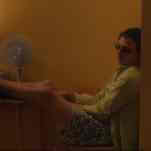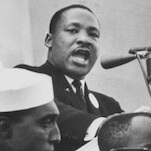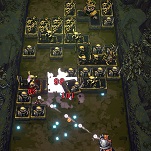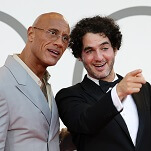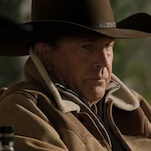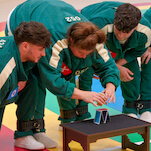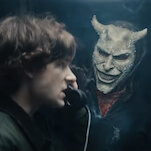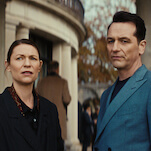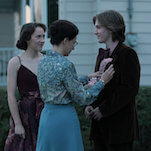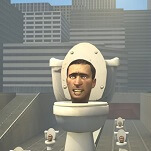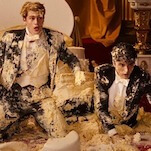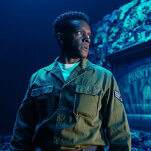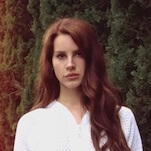DC You is the biggest shake up in the DC universe since the New 52, and just a few weeks in the landscape looks remarkably different. John Constantine is openly flirting with men, Section 8 is back in business, and Koriand’r has gone off on her own, leaving Jason and Roy to carry on without her. Starfire #1 (DC) has a lot of expectations to carry: The treatment of the titular character in Red Hood And The Outlaws #1 resulted in some of the most vocal fan complaints about the New 52. Though it shifted focus and sold well, Red Hood And The Outlaws never quite shook the impression that it was doing a disservice to a beloved character, at least for people who weren’t reading.
Led by writing team Amanda Conner and Jimmy Palmiotti, who’ve been earning attention and praise for their work together on Harley Quinn, Starfire #1 finds Kori alone in Key West, trying to explain to the sheriff who she is. Why she’s in the police station is never explained, but the sheriff’s ignorance gives the writers a great opportunity to catch the reader up on Starfire’s backstory. As a #1, it’s no surprise that the main focus of the issue is introductions: The readers meet characters as Kori does and it’s established early on who will greet her unabashed enthusiasm with cynicism and who will grin and hold on for a wild ride.
Penciller Emanuela Lupacchino, inker Ray McCarthy, and colorist Hi-Fi make the book a visual riot in the best way. Appropriate for both Kori and Key West, the people are beautiful and the colors are bright and vibrant. What’s even more gratifying is that several of the characters set up to be recurring guest stars in Kori’s life are people of color, far closer to the actual racial diversity in Key West than you could expect from many comic books. The way that Lupacchino demonstrates Kori’s confusion with metaphors and idioms is almost unbearably adorable.
This is a huge shift in tone for Starfire, and not just from her Red Hood And The Outlaws days. Conner and Palmiotti’s Kori is closer to her Teen Titans cartoon self than any other version. This Kori is bright and positive and bubbly, but she also seems very naive, and not just of Earth; the thing that makes her “alien” also makes her seem unaware of herself and her own desires. Teen Titans’ Kori made sense like this; she was literally a teenage girl, coping with a new planet and her own inexperience. On the other hand, Starfire’s Kori is (or at least appears to be) a grown woman.
One of the biggest complaints leveled at Red Hood And The Outlaws #1, after Kori’s beach reveal, was that she didn’t remember her loved ones. Jason and Roy had backstories that spanned years, friends, and family. But Kori didn’t have any memories of her previous time on Earth, despite the fact that she has more than one of Dick Grayson’s Robin and Nightwing suits on her ship. And now the same complaint can be leveled at Starfire #1. The very last thing Kori said to Roy in Red Hood And The Outlaws #40 was that she would remember him “forever and a day.” But neither Roy nor Jason, nor even her sister’s grievous injury and Kori’s journey to heal her get a mention in Starfire #1, and it robs her character of something important. This isn’t to say the book is bad, of course. The writing is excellent, the art is beautiful, and it’s awesome to have another fun and lighthearted book in the DC roster, particularly for Kori. But, for now, Starfire is still guilty of the same crime its much-criticized predecessor was, and it’s disappointing that in order to be flying solo it appears Starfire needs to lose what lends her the most strength: her capacity for deep, abiding love. [Caitlin Rosberg]
Christian Dior changed the course of fashion history when he debuted his first collection in 1947, revealing a “New Look” that would redefine women’s clothing after World War II. That groundbreaking event gets ample spotlight in Annie Goetzinger’s
Girl In Dior (NBM), which details the fictional journey of a young fashion journalist sitting in the crowd of that first showing as she goes from writing about Dior’s designs to modeling them on the runway. Originally published in France in 2013, this graphic novel is a gorgeously illustrated tribute to the refined elegance of Dior’s designs and the passionate community he built inside his fashion house, but it’s less successful as a character study.
Goetzinger condenses a very eventful decade of Dior’s life into just over 100 pages, and the main character, Clara, is primarily a way for the cartoonist to hit the major Dior beats while maintaining a distance that prevents the book from being a full-fledged biography. Unfortunately, Clara isn’t very compelling on her own. She’s defined by her relationship to the designer and his clothes, and Goetzinger rushes through the major events in Clara’s life that don’t directly involve Dior. There’s a hasty romance added toward the end of the book that gives Clara a fairy- tale happy ending, but Goetzinger spends minimal time on building an emotional foundation for the relationship.
The strongest moments of Goetzinger’s script come when she embraces a slower pace, showing quieter character moments with more subtle storytelling. An eight-page sequence of Dior at his country house designing an upcoming collection highlights the luxurious loneliness of his lifestyle, and Goetzinger contrasts Dior’s personal longing with rich natural imagery and ornate home décor. It’s clear that Dior wants companionship, but he sacrifices that for his world of beauty. And it is beautiful.
There are some missteps in the writing, but the script mostly functions as connective tissue between Goetzinger’s striking illustrations. Just like with Dior’s work, the allure of this graphic novel is in the visuals, and Goetzinger draws the reader into the glamorous world of Dior’s Paris with her gentle but intricately detailed linework. Her clean line is perfect for realizing Dior’s sleek designs, and her characters model these ensembles for maximum dramatic impact. The fashion-show scenes are stunning showcases of Goetzinger’s skill for fashion illustration, and it’s easy to see how Dior’s collections made huge waves thanks to the energy and excitement Goetzinger brings to the page when the dresses become the top priority.
In many ways, Goetzinger’s artwork draws attention to the craftsmanship of the people that bring this dress to the public. The models have a very specific way of carrying themselves that is far removed from the body language of the people sitting in the audience, and it’s fascinating to see how a small detail like changing the size of a flower on a hat can alter an entire look because the design is all about compositional balance and the perfect proportions. Girl In Dior could use more work making the girl an intriguing character, but the strength of the Dior elements makes it a worthwhile read, especially for fashion buffs. [Oliver Sava]
The heyday of romance comics in the American mainstream was the late 1940s and 1950s. With the superhero market in steep decline following the end of the war, publishers responded by increasing the diversity of genres available—not just adventure and funny animal books, but increasingly crime, horror, and Westerns as well. The Joe Simon and Jack Kirby team are traditionally credited with producing the first romance comic book—1947’s
Young Love—even if they were preceded by the release of
Romantic Picture Novelettes in mid-1946. (That compilation of
Mary Worth newspaper strips somehow failed to set the publishing world on fire.) It wasn’t long before
Young Love was selling in the millions, and the industry was working overtime to appeal to the nascent libidos of girls across the nation.
With dozens of publishers flooding the market, it’s easy to see that not every book was quite up to Simon and Kirby standards. These stories are the focus of Weird Love (IDW/Yoe Books), an anthology devoted to showcasing the worst of the worst in the world of old-school romance books. It’s not just that these stories showcase obsolete and offensive gender stereotypes—that’s a given, so caveat emptor. The material featured in Weird Love takes another step altogether, into the world of the surreal, the hysterical, and the downright dumb.
The volume begins with “I Fell For A Commie,” a Red Scare-era example of Red-baiting at its best. Although no writer is credited, Al Citron produces characteristic art for the period, with stiffly staged longing looks and gorgeous coifs taking the panel focus that would, in different kinds of comic, go to garish multicolored costumes or severed heads. The lack of writing credits for “I Fell For A Commie” is especially frustrating since the story presents an odd contradiction: while it is obviously intended to warn young women of the hazards of falling in love with a Communist, it also presents a surprisingly sympathetic view of American Communism in the years between the end of the War and the internecine conflict of the post-Stalin late ’50s. Even though the story ends with our star-crossed lovers cheerfully dropping a dime regarding the anti-American activities of the Young Americans club, that is an unconvincing denouement for a story that involves Gladys being treated with nothing but kindness by the even-tempered Reds.
The rest of the book offers similarly unconvincing takes on hot-button issues such as mental illness (“Love Of A Lunatic!”), male chauvinism (“The Taming Of The Brute”), and, er, coulrophobia (“Weep, Clown, Weep!”). There’s a story about mini-skirts being too much of a distraction in the modern workplace, swingers in the 1960s, and something about a bear in the Bronx Zoo bringing together two mismatched lovers through what can only be described as zoo bear shenanigans. There’s a sad story about a lonely fat girl who appears, based on the art, to be about a size 6. Nothing here is deserving of preservation on merit, but as exemplars of some of the industry’s less auspicious moments, there’s a lot here to interest comics fans of all stripes. [Tim O’Neil]
To all intents and purposes, nature is God. It is both harsh and benevolent and seemingly indifferent. It provides little answers, but raises many questions. Everything man has attained and built comes from the Earth and what is placed on it: plants, animals, food, shelter, minerals, resources. And yet it remains implacable and unknowable; beyond man. It is into the vastness of this literal and figurative landscape that Disa Wallander’s bumbling documentary maker strides confidently forward.
To those familiar with Wallander’s work, the double-pigtailed protagonist is immediately recognizable. A cross between a Thomas Dam Danish troll doll and a Flintstones character, this is Disa Disa, a persona of the author regularly encountered in her Slowly Dying comic strips. Here, she sets out to discover the “true nature of nature,” extrapolating on man’s relationship with the great outdoors as she canoes down a river. She ponders the ways in which man attempts to understand nature by personifying it, conquering it, and breaking it down in order to quantify it. If man can make it small and knowable—bring it down to his level—then he need not fear it. Animals and plants and rocks become whatever we want them to be. We can frame nature as terrifying and romantic and evil and beautiful when it suits a purpose. It is somehow unthinkable that all this may just be. No, it has to be in relation to man. Wallander encapsulates the drive of this ridiculously uneven dichotomy throughout: “Do we come from this deep dark hole? Does it want us back? Or will we have to kill it? Let’s film it and then kill it.”
The Nature Of Nature (Peow! Studio) feels like an organic progression of Wallander’s Slowly Dying strips. As Disa Disa tramples from plant to rock, shoving a microphone in their direction and asking inane questions, her overt bluster of dumb is actually anything but. As much as she’s a representation of our species, her statements and behavior are ostensibly aimed more at the reader than her purported subjects, eliciting a chain of thought leading to a degree of despair and existential crisis. The cliché of a return to original surroundings, away from all the extra trappings, throws into relief the rootlessness of the self—possibilities, doubts, regrets, and freedoms. That’s often the sort of sly narrative course Wallander’s comics will take: a philosophical hypothesis will be presented, possible conclusions/resolutions explored, and then ultimately often rejected—because what does it all matter anyway? Life is brief, so stop pontificating; it’s apprehension and reassurance all in one package. Perhaps it’s a false kind of reassurance, the kind you want to believe in due to fears and limitations, but who’s to say apprehension is any more valid?
The key to Wallander’s work is that it is both genuine in its explorations and dry humor. She ponders the meaning of life while simultaneously acknowledging the triteness of the subject, and the perceived pretentiousness of being sucked into the mental whirlpool of questioning existence. Yet there is something—a touch of sweetness—that makes her comics strangely affirming. A shrug and the reassurance of irrelevance. [Zainab Akhtar]

